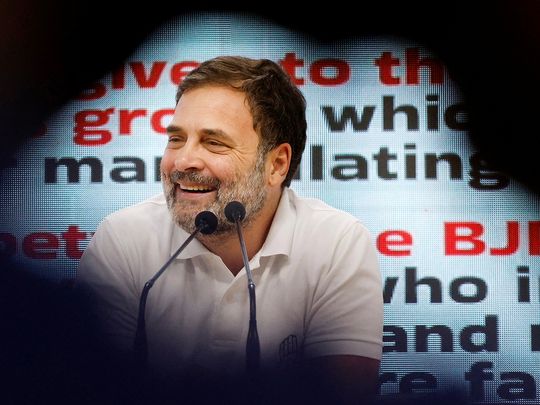
India’s Prime Minister Narendra Modi gave a surprisingly large number of interviews during the 2024 Lok Sabha elections. Congress leader Rahul Gandhi did not give a single interview during the whole campaign — not one, not even to a friendly YouTube channel.
This is part of the reason why the 2024 elections could not become the usual Modi-versus-Rahul dichotomy.
Rahul Gandhi’s gaffes — real, fake, or edited videos — didn’t dominate the election conversation on social media like they used to.
His election rally speeches didn’t get good play on social or mainstream media, and the second edition of the Bharat Jodo Yatra (Unite India march), in the weeks before the election, didn’t make much impact. By having a non-Gandhi as party president and holding no post himself, he effaced himself from the main stage to some extent.
All of this ensured the election wasn’t seen as Modi versus Rahul. It was often Bharatiya Janata Party (BJP) vs. INDIA combine.
The BJP seemed to understand the problem but couldn’t do much about it. The prime minister’s comments on Rahul Gandhi — even making a rare exception of mentioning him by name and tweeting a contrast video of Rahul and himself — didn’t elicit the response they used to.
Displacement activity
Rahul Gandhi has successfully managed to shed the image of a clueless young man, regardless of how fair or unfair that tag was. That the BJP’s barbs against him are no longer working is the ultimate proof that Rahul Gandhi has finally evolved.
He has done so by displacing the label with the radical left image. After the 2019 debacle, Rahul Gandhi found refuge in ideology.
When his party seemed to dither in taking a strong stand for secularism, he was willing to go the extra mile for it. He championed the caste census, an issue his party used to be evasive about.
The Bharat Jodo Yatra also neutralised the criticism that he was a reluctant part-time politician. Yet it wasn’t enough to transform him into someone people desired as a prime ministerial candidate.
A Lokniti-CSDS survey has claimed that people in Uttar Pradesh preferred him to Modi as prime minister. With due respect, this is bunkum.
If Rahul Gandhi was ahead of Modi in PM choice ratings in the most important Hindi heartland state, the Congress would have been in power already.
Getting there
The question is, can Rahul Gandhi get there? There was a time when it seemed impossible he would ever shed the old tag. Today he has, with some help from the BJP’s own anti-incumbency. If he has managed this, how does he get to the next level?
Five years ago, when voters were asked why they were voting for BJP despite unemployment, the answer would be, ‘Can Rahul Gandhi create jobs?’
Today unemployed youth are not defending the BJP and were seen voting against it in many places, especially in UP. They don’t mention Rahul Gandhi anymore, which means they do not speak positively or negatively about him.
The leader has to be ready
When asked about Rahul Gandhi, a common refrain from voters today is that they don’t know much about him. That’s an odd thing to say — what they mean is that they haven’t seen him govern.
This points to Rahul Gandhi’s blunder of not accepting any ministerial post in 2004-2014 when his party was leading the UPA coalition.
He was president of the Congress party for less than two years. How do voters know he has the ability to perform a task as difficult as running a country of 1.4 billion people? That’s a big ask.
Indians have always trusted leaders who have shown a past track record of governance or being engaged with affairs of the state. Narendra Modi’s big pitch in 2014 was that he had demonstrated his abilities in Gujarat (“Gujarat model”) to be given a chance nationally.
Just as Modi shifted his image from radical right to a mainstream governance image as Gujarat chief minister, Rahul Gandhi would now benefit from shifting his image from radical left to mainstream governance.
The best way to do so would be to accept the post of Leader of the Opposition in the Lok Sabha and speak as a serious speaker on matters of governance, policy, and public welfare.
2024 has shown the possibilities that open up in Indian politics in unexpected ways. When the people feel the nation is in crisis, they search for a leader. The leader has to be ready.











